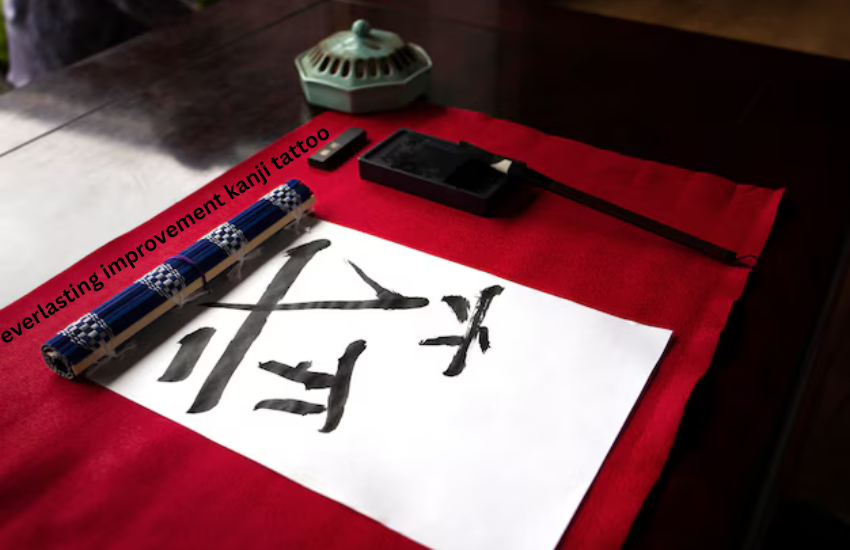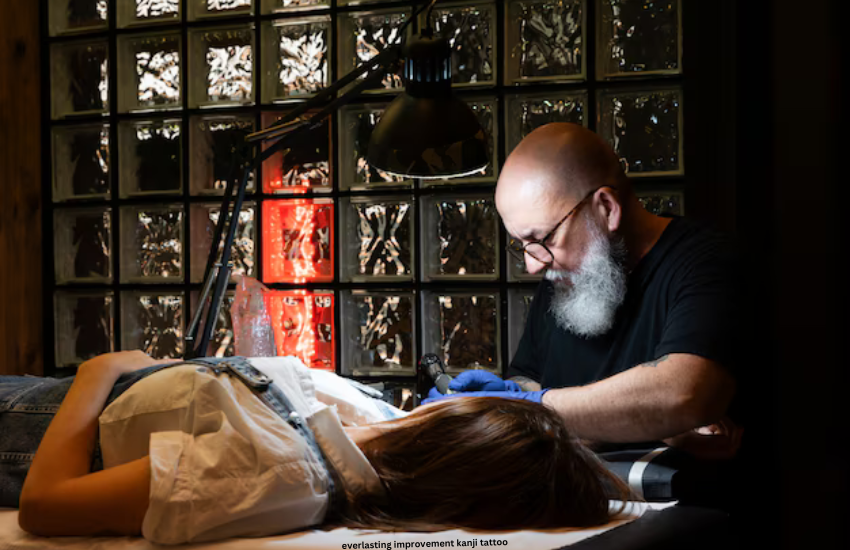History of Kanji Tattoos
Origins of Kanji Writing
Kanji characters originated in ancient China and were introduced to Japan around the 5th century AD. The Japanese adapted these characters to fit their language, creating a complex and beautiful writing system. Kanji is one of the three scripts used in written Japanese today, alongside hiragana and katakana.
Evolution into Tattoos
The art of tattooing in Japan, known as irezumi, has a long history that dates back to the Jomon period (10,000 BCE – 300 BCE). Initially, tattoos were used for spiritual and decorative purposes. Over time, they evolved to include kanji characters, which allowed for the expression of personal beliefs and aspirations through permanent body art.
Cultural Significance in Japan
In Japan, tattoos have historically been associated with various cultural meanings, ranging from spiritual protection to criminal affiliation. However, in modern times, they have also become a form of self-expression and a way to convey personal values and ideals.
Understanding Kanji
Basic Structure of Kanji
Kanji characters are made up of strokes, which are the individual lines and marks that create the character. Each kanji can represent a word or a part of a word and can have multiple meanings depending on its context.
Different Types of Kanji
There are several types of kanji, including:
- Pictographs: Characters that represent objects or concepts visually (e.g., 山 for “mountain”).
- Ideographs: Characters that represent abstract ideas (e.g., 上 for “above”).
- Compound Characters: Characters that combine elements of other kanji to create new meanings (e.g., 明, which combines 日 “sun” and 月 “moon” to mean “bright”).

Common Misconceptions
One common misconception is that kanji characters are simple and universally understood. In reality, kanji can be complex, and their meanings can vary significantly based on context. It’s essential to understand the specific nuances of each character to ensure accurate representation.
Meaning of “Everlasting Improvement”
Definition of Each Kanji Character
The phrase “everlasting improvement” can be translated into kanji as 永遠の改善. Let’s break down the meaning of each character:
- 永 (Ei): This character means “eternal” or “forever.”
- 遠 (En): While this character means “distant” or “far away,” it is often paired with 永 to emphasize the concept of eternity.
- 改善 (Kaizen): This compound word means “improvement” or “change for the better,” with 改 (Kai) meaning “to change” and 善 (Zen) meaning “good” or “virtuous.”
Symbolism and Interpretation
Together, 永遠の改善 (Ei-en no Kaizen) symbolizes the continuous pursuit of self-betterment and growth. It conveys a commitment to lifelong learning and improvement, making it a powerful and motivational choice for a tattoo.
Choosing the Right Kanji
Importance of Accurate Translation
Accurate translation is crucial when choosing kanji for a tattoo. Mistranslations can lead to characters that do not convey the intended meaning or, worse, mean something entirely different.
Consulting Native Speakers and Experts
To ensure the accuracy of your kanji tattoo, it’s wise to consult native Japanese speakers or experts in the language. They can provide insights into the correct characters and their appropriate combinations.
Avoiding Common Mistakes
Some common mistakes include choosing characters that look visually appealing but do not make sense together or using kanji that are culturally inappropriate. Thorough research and expert consultation can help avoid these pitfalls.
Designing Your Kanji Tattoo
Combining Art and Meaning
A kanji tattoo should balance artistic design with meaningful representation. Consider the size, style, and placement of the tattoo to enhance its visual appeal while maintaining its significance.
Font and Style Variations
There are various font styles for kanji tattoos, ranging from traditional calligraphy to more modern, stylized fonts. Choose a style that resonates with you and complements the overall design of the tattoo.
Placement Ideas
The placement of your kanji tattoo can significantly impact its appearance and meaning. Popular locations include the back, forearm, wrist, and ankle. Consider how the tattoo’s size and visibility align with your personal and professional life.
Tattoo Artists and Studios
Finding a Reputable Artist
Choosing a skilled and experienced tattoo artist is crucial for a successful kanji tattoo. Look for artists with a portfolio that includes kanji tattoos and check reviews from previous clients.
Questions to Ask Your Tattoo Artist
Before committing to a tattoo artist, ask about their experience with kanji tattoos, their understanding of the characters’ meanings, and their process for ensuring accuracy.
Examples of Quality Kanji Tattoos
Researching examples of well-done kanji tattoos can provide inspiration and help you set realistic expectations for your design. Look for tattoos that are not only visually appealing but also accurately represent the chosen characters.
Tattoo Process and Aftercare
Preparing for Your Tattoo
Preparation is key to a smooth tattooing experience. Ensure you are well-rested, hydrated, and have eaten before your appointment. Wear comfortable clothing and bring any necessary documents or designs.
The Tattooing Process
During the tattooing process, the artist will outline and fill in the design. This can take several hours depending on the tattoo’s size and complexity. Communicate with your artist throughout to ensure your comfort and satisfaction.
Aftercare Tips and Guidelines
Proper aftercare is essential for healing and maintaining the quality of your tattoo. Follow your artist’s instructions, which typically include keeping the tattoo clean, moisturized, and protected from direct sunlight.
Personal Stories and Experiences
Testimonials from People with Kanji Tattoos
Hearing from individuals who have kanji tattoos can provide valuable insights and inspiration. Many people choose kanji tattoos to represent significant life experiences or personal philosophies.
Lessons Learned
Personal stories often highlight lessons learned, such as the importance of accurate translation and choosing a skilled artist. These experiences can guide you in making informed decisions about your tattoo.

Cultural Respect and Sensitivity
Understanding Cultural Appropriation
It’s important to recognize and respect the cultural significance of kanji and Japanese tattooing traditions. Cultural appropriation occurs when elements of one culture are used without understanding or respect for their original context.
Showing Respect for Japanese Culture
Demonstrating respect for Japanese culture involves researching the history and meaning of kanji, acknowledging their cultural significance, and approaching the tattoo process with sensitivity and awareness.
Ethical Considerations
Ethical considerations include ensuring your tattoo does not trivialize or misrepresent Japanese culture. Choose designs that honor the tradition and convey genuine appreciation.
FAQ
What Should I Know Before Getting a Kanji Tattoo?
Before getting a kanji tattoo, research the characters’ meanings, consult with experts, and choose a reputable tattoo artist.
How Can I Ensure My Kanji Tattoo Is Accurate?
Consult native Japanese speakers, use reliable translation resources, and verify the design with multiple sources.
What Are the Best Practices for Tattoo Aftercare?
Follow your tattoo artist’s aftercare instructions, which typically include cleaning, moisturizing, and protecting the tattoo from sunlight.
Can I Remove or Modify a Kanji Tattoo Later?
Tattoo removal and modification are possible but can be expensive and time-consuming. Consider your decision carefully before getting a tattoo.
What Are the Common Mistakes with Kanji Tattoos?
Common mistakes include mistranslations, poor design choices, and choosing characters that do not convey the intended meaning.
How Much Does a Kanji Tattoo Typically Cost?
The cost of a kanji tattoo varies based on the size, complexity, and the artist’s experience. Prices can range from $50 to several hundred dollars.
Conclusion
In conclusion, a kanji tattoo representing “everlasting improvement” is a meaningful and inspiring choice. By thoroughly researching the characters, consulting with experts, and choosing a skilled tattoo artist, you can ensure your tattoo is both beautiful and accurate. Remember to respect the cultural significance of kanji and approach the process with care and consideration.
Resources and Further Reading
- Recommended Books: “The Japanese Tattoo” by Sandi Fellman, “Bushido: The Soul of Japan” by Inazo Nitobe.
- Websites: Japanese dictionary websites, tattoo artist portfolios, and forums on Japanese culture and language.


